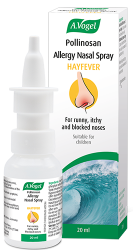Hayfever and the weather
In my blog ‘What effect does the weather have on hayfever sufferers?’ I discussed how sunshine, wind and storms can both ease hayfever symptoms and increase their severity. In the sunshine for example, plants are more likely to release their pollen meaning that the likes of congestion and watery eyes can become more prominent. Also, when the temperature is warm pollen can rise with the heat. This means it can easily get into the nose and eye area thus intensifying hayfever symptoms here.

Humid thunder storms are also problematic for those with hayfever because it can cause pollen grains to gain water and then burst open. This releases lots of small pollen grains into the air meaning they become more of an issue for hayfever sufferers. Also, on windy days pollen can spread further and so again this can contribute to worsening hayfever symptoms.
Nevertheless, here in the UK, regardless of the season, rain is the weather condition we are most familiar with and so that’s why I’ve dedicated a whole blog to examining what effect it has on the pollen count.
Rain and falling pollen count
Although many people complain at the first sign of a shower, for hayfever sufferers it can actually bring some relief. That’s because rain washes pollen away thereby reducing the overall pollen count. However, it should be noted that in order to wash pollen away, rainfall must be powerful and long-lasting as a little drizzle will not have a significant impact on pollen counts.
Rain and increasing pollen count
Although rain generally helps to reduce the pollen count, there are a few occasions when it can do the opposite.
Stormy weather
When rain is accompanied by thunder and lightning, many of us, where possible, will understandably seek shelter from the elements. However, at this time it is even more important that hayfever sufferers stay indoors as thunderstorms can increase the pollen count.

The reason for this is simple. Storms are usually accompanied by humid conditions which can, as I already mentioned, cause pollen grains to gain water and then burst open. This releases an abundance of pollen into the air and thus raises the overall pollen count. This phenomenon is sometimes known as thunder hayfever where rapid changes to wind, temperature and humidity cause pollen grains to explode. As they are then smaller, these pollen grains are easily breathed in through the nose and mouth thus worsening the already problematic symptoms of hayfever.
Grass pollination
We all know that pollen helps plants and grass to grow but they also need it for pollination too. As a result, if rainfall is heavy in spring, plants and grass can grow quicker and therefore produce more pollen. In this way rainfall can actually contribute to higher pollen counts.
Autumn rain
Heavy rainfall in the autumn and early winter can also raise pollen levels the following spring. That’s because when rainfall is high in the later months of the year, trees such as cedars and oak go on to produce more pollen.
Is pollen count lower when it rains?
There are occasions when rain causes pollen levels to fall for example, if showers are long and persistent and conditions aren’t humid. However, if rainfall is accompanied by heat, storms and if the season is right, then pollen counts can actually increase.
What can you do when pollen counts are high?
I have many blogs that offer advice on how to deal with hayfever but as a reminder, here are a few simple tips you can use when pollen counts are high.

Limit your exposure to pollen – when pollen counts are at their highest make try to stay indoors, roll up your car windows and keep the windows in your home closed. To circulate fresh air you can use a fan or air conditioning
Wash away pollen – if you’ve been outdoors when the pollen counts are high I’d recommend changing out of your clothes when you return home to avoid spreading pollen around. If you have time you could even take a shower as this will get rid of any pollen that may be lurking in your hair and on your skin
Address your symptoms – when pollen counts are high it can be hard to avoid the onset of hayfever symptoms completely so at this stage you could use herbal remedies to address the problem. The Pollinosan Luffa Nasal Spray cleanses the nose of pollen and in doing so it helps to restore fluid and moisture there. This soothes the area and makes it feel more comfortable
Watery, itchy and red eyes are another common complaint of hayfever sufferers so in this instance you could turn to our Moisturising Eye Drops. These restore comfort to irritated eyes, plus they can be used by those who wear contact lenses.









